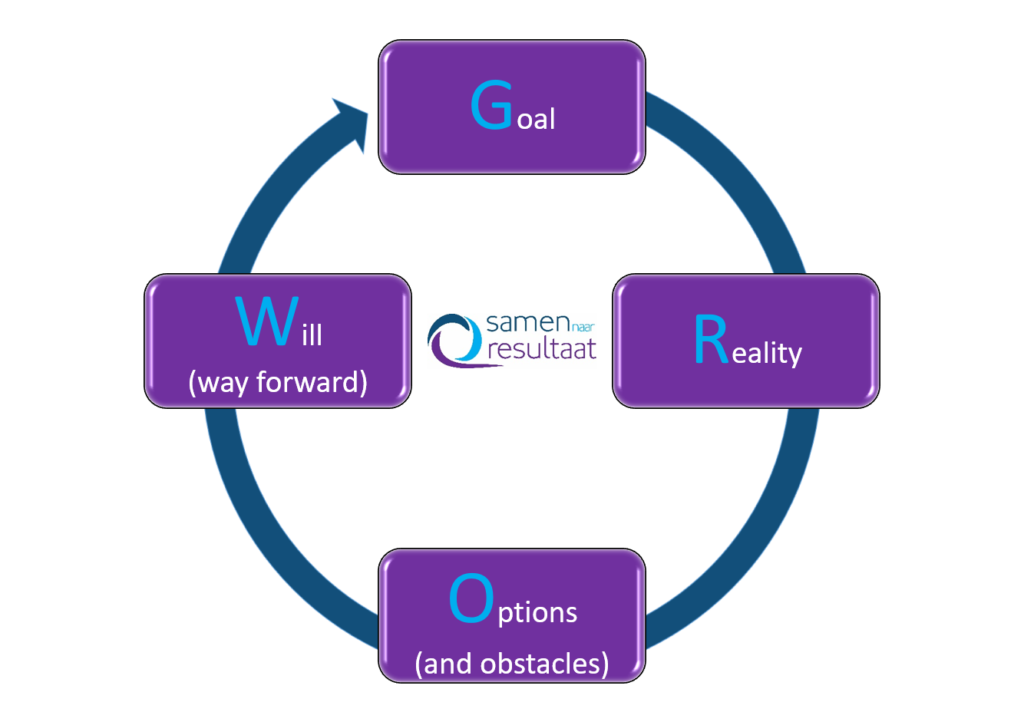Coaching co-workers with GROW
 Do you recognize this? Someone at work comes to you with a problem or frustration and you really don’t know what to do with it? You want to help, but you don’t have a solution yourself? Or it’s not your place to solve the problem? But you do want to help the other to solve it?
Do you recognize this? Someone at work comes to you with a problem or frustration and you really don’t know what to do with it? You want to help, but you don’t have a solution yourself? Or it’s not your place to solve the problem? But you do want to help the other to solve it?
John Whitmore’s GROW model helps you get co-workers back on track in about 20 minutes. Win-win!
The approach is that someone will come up with the solution themselves. This is done in 4 steps:
 G = Goal that needs to be achieved
G = Goal that needs to be achieved
R = Reality
O = Options
W = Will (Way forward)
If you want to get this done in 20 minutes, first of all, realize that you have to do LESS. You don’t have to provide a solution!
Well, that’s a good start. Right? It also gives you the space to become curious and above all ask (open!) questions. Someone who comes up with solutions himself is much more likely to apply them. Don’t be afraid to drop silences; allow the other person his or her own thought process.
How does the model work in practice? Very simple:
1. Determine desired goal
First, determine the purpose of this conversation and/or of the larger topic that someone is involved in. If you suspect that someone just wants to ventilate some emotions and will then solve it themselves, fine. Bring that out in the open: “Do you just want to ventilate, or do you want me to help you find a solution?” If it’s the first, give (limited) space for that and leave it: “Fine, the next 10 minutes are all for you, go ahead”. (If this happens every week, you might want to give that another thought…..).
If someone indicates that they would like your help to resolve the situation, you can briefly indicate that you want to do so through the GROW model. Questions you can ask to clarify the goal: What do you want me to help you with, with what result do you want to leave this conversation?
2. Establish reality
Take the other person back to the facts. Ask questions to let the other person discover what the current situation really is. What really happened, what is perception? Ask open questions that start with ‘What’, ‘When’, ‘Where’, ‘Who’, ‘How many’, ‘How often’, etc.,. Ask with the intention to allow the other one to gain more clarity on the issue and what this is really about.
3. Options and obstacles
At this stage you help the other person discover what options are available. You can assist with brainstorming, but above all use this to keep the other person going. Example questions: What would you really like to do now (even if that is totally not done)? What are the pros and cons per option? What could you come across and how would you best deal with it? What if you don’t do anything?
4. Way forward
At this stage, you make sure that what’s intented is actually going to happen. Ask clear questions, divide the action into smaller pieces. What are you going to do now, which option do you choose? When are you going to do that? What do you need for that? When are you going to let me know how it ended?
Get started
 Do you want to dive into this a but further or get started right away?
Do you want to dive into this a but further or get started right away?
Feel free to immediately plan a half hour sparring with Sandra Geelink directly in the agenda.

